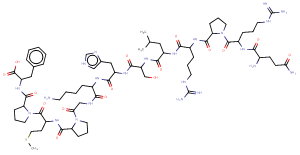
Apelin-13
CAS No. 217082-58-1
Apelin-13( —— )
Catalog No. M20938 CAS No. 217082-58-1
Apelin-13 is an endogenous ligand of the APJ receptor.Apelin-13 could protect against apoptosis induced by ischemic/reperfusion (I/R).
Purity : >98% (HPLC)
 COA
COA
 Datasheet
Datasheet
 HNMR
HNMR
 HPLC
HPLC
 MSDS
MSDS
 Handing Instructions
Handing Instructions
| Size | Price / USD | Stock | Quantity |
| 5MG | 135 | Get Quote |


|
| 10MG | 231 | Get Quote |


|
| 25MG | 417 | Get Quote |


|
| 50MG | 625 | Get Quote |


|
| 100MG | Get Quote | Get Quote |


|
| 200MG | Get Quote | Get Quote |


|
| 500MG | Get Quote | Get Quote |


|
| 1G | Get Quote | Get Quote |


|
Biological Information
-
Product NameApelin-13
-
NoteResearch use only, not for human use.
-
Brief DescriptionApelin-13 is an endogenous ligand of the APJ receptor.Apelin-13 could protect against apoptosis induced by ischemic/reperfusion (I/R).
-
DescriptionApelin-13 is an endogenous ligand of the APJ receptor.Apelin-13 could protect against apoptosis induced by ischemic/reperfusion (I/R).
-
In Vitro——
-
In VivoApelin-13 (200 μg/kg; IP, daily for 4 weeks) improves cardiac function, improves insulin resistance, improves lipid metabolism, significantly decreases TNF-α and leptin on serum,induces the expression of Apelin-12 in serum and markedly elevates GLUT4 and p-AMPKα2 levels.Apelin-13 (10 and 100 μM; ICV, single dosage) increases the spontaneous discharges in the majority of pallidal neurons. Animal Model:Goto-Kakizaki (GK) rats (12 weeks old; 240-280 g; fed with a high-fat diet: 66.5% standard chow, 10% lard, 20% sucrose, 2.5% cholesterol and 1% pig bile salt)Dosage:200 μg/kg Administration:IP, daily for 4 weeks Result:Significantly decreased heart rate; lowered the levels of fasting plasma glucose (FPG), fasting insulin (FINS) and homeostasis model assessment for insulin resistancey (HOMA-IR); decreased serum levels of total cholesterol (TC), triglyceride (TG) and low density lipoprotein-cholesterol (LDL-C) and increased high density lipoprotein-cholesterol (HDL-C); decreased NO level, cNOS activity, TNF-α and leptin in serum; induced the expression of Apelin-12.Animal Model:Adult Wistar rats (SPF, 8-10 weeks, 240-280 g)Dosage:10 and100 μM Administration:ICV, single dosage Result:Increased the spontaneous discharges in the majority of pallidal neurons.
-
Synonyms——
-
PathwayOthers
-
TargetOther Targets
-
RecptorOthers
-
Research Area——
-
Indication——
Chemical Information
-
CAS Number217082-58-1
-
Formula Weight1550.83
-
Molecular FormulaC69H111N23O16S
-
Purity>98% (HPLC)
-
Solubility——
-
SMILESCSCCC(NC(=O)C1CCCN1C(=O)CNC(=O)C(CCCCN)NC(=O)C(Cc1c[nH]cn1)NC(=O)C(CO)NC(=O)C(CC(C)C)NC(=O)C(CCCNC(=N)N)NC(=O)C1CCCN1C(=O)C(CCCNC(=N)N)NC(=O)C(N)CCC(N)=O)C(=O)N1CCCC1C(=O)NC(Cc1ccccc1)C(=O)O
-
Chemical Name——
Shipping & Storage Information
-
Storage(-20℃)
-
ShippingWith Ice Pack
-
Stability≥ 2 years
Reference
1.Duan J Cui J Yang Z et al. Neuroprotective effect of Apelin 13 on ischemic stroke by activating AMPK/GSK-3β/Nrf2 signaling[J]. Journal of Neuroinflammation 2019 16(1).
molnova catalog



related products
-
Proinsulin C-Peptide...
Human proinsulin, the single-chain peptide precursor of insulin, consists of the insulin A and B chains connected by the 31 amino acid C-peptide. Cleavage of proinsulin by proteolytic enzymes produces insulin and free C-peptide.
-
SW2_110A
SW2_110A is a cell-permeable, selective chromosome group 8 chromosome domain (CBX8 ChD) inhibitor with a Kd of 800 nM.
-
Bromodeoxyuridine (B...
Bromodeoxyuridine (BrdU) is a nucleoside analog that competes with thymidine for incorporation into DNA, and used in the detection of proliferating cells.



 Cart
Cart
 sales@molnova.com
sales@molnova.com


